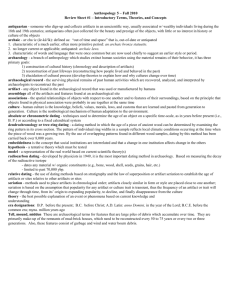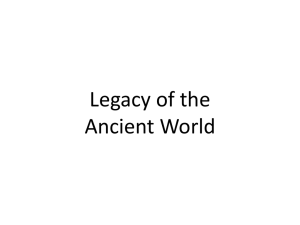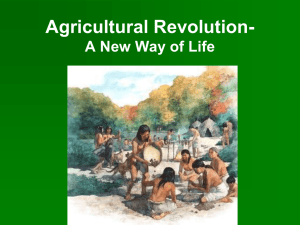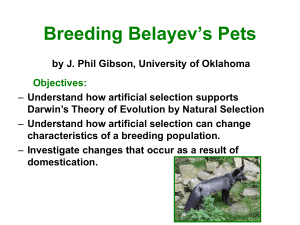Review Sheet 2
advertisement
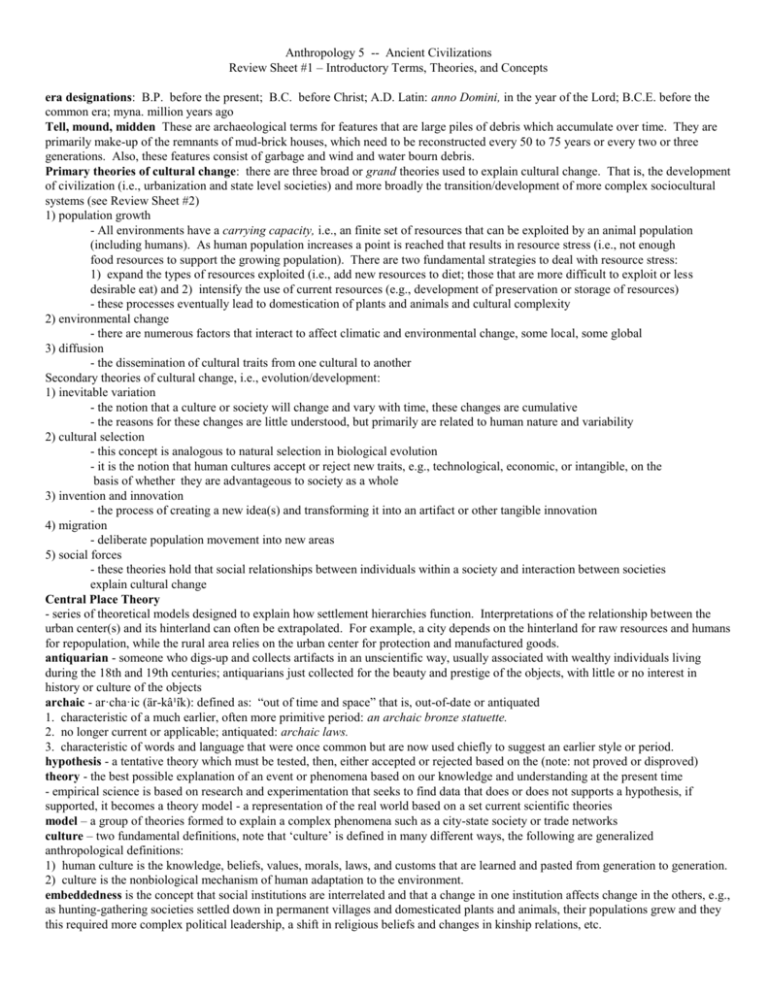
Anthropology 5 -- Ancient Civilizations Review Sheet #1 – Introductory Terms, Theories, and Concepts era designations: B.P. before the present; B.C. before Christ; A.D. Latin: anno Domini, in the year of the Lord; B.C.E. before the common era; myna. million years ago Tell, mound, midden These are archaeological terms for features that are large piles of debris which accumulate over time. They are primarily make-up of the remnants of mud-brick houses, which need to be reconstructed every 50 to 75 years or every two or three generations. Also, these features consist of garbage and wind and water bourn debris. Primary theories of cultural change: there are three broad or grand theories used to explain cultural change. That is, the development of civilization (i.e., urbanization and state level societies) and more broadly the transition/development of more complex sociocultural systems (see Review Sheet #2) 1) population growth - All environments have a carrying capacity, i.e., an finite set of resources that can be exploited by an animal population (including humans). As human population increases a point is reached that results in resource stress (i.e., not enough food resources to support the growing population). There are two fundamental strategies to deal with resource stress: 1) expand the types of resources exploited (i.e., add new resources to diet; those that are more difficult to exploit or less desirable eat) and 2) intensify the use of current resources (e.g., development of preservation or storage of resources) - these processes eventually lead to domestication of plants and animals and cultural complexity 2) environmental change - there are numerous factors that interact to affect climatic and environmental change, some local, some global 3) diffusion - the dissemination of cultural traits from one cultural to another Secondary theories of cultural change, i.e., evolution/development: 1) inevitable variation - the notion that a culture or society will change and vary with time, these changes are cumulative - the reasons for these changes are little understood, but primarily are related to human nature and variability 2) cultural selection - this concept is analogous to natural selection in biological evolution - it is the notion that human cultures accept or reject new traits, e.g., technological, economic, or intangible, on the basis of whether they are advantageous to society as a whole 3) invention and innovation - the process of creating a new idea(s) and transforming it into an artifact or other tangible innovation 4) migration - deliberate population movement into new areas 5) social forces - these theories hold that social relationships between individuals within a society and interaction between societies explain cultural change Central Place Theory - series of theoretical models designed to explain how settlement hierarchies function. Interpretations of the relationship between the urban center(s) and its hinterland can often be extrapolated. For example, a city depends on the hinterland for raw resources and humans for repopulation, while the rural area relies on the urban center for protection and manufactured goods. antiquarian - someone who digs-up and collects artifacts in an unscientific way, usually associated with wealthy individuals living during the 18th and 19th centuries; antiquarians just collected for the beauty and prestige of the objects, with little or no interest in history or culture of the objects archaic - ar·cha·ic (är-kâ¹îk): defined as: “out of time and space” that is, out-of-date or antiquated 1. characteristic of a much earlier, often more primitive period: an archaic bronze statuette. 2. no longer current or applicable; antiquated: archaic laws. 3. characteristic of words and language that were once common but are now used chiefly to suggest an earlier style or period. hypothesis - a tentative theory which must be tested, then, either accepted or rejected based on the (note: not proved or disproved) theory - the best possible explanation of an event or phenomena based on our knowledge and understanding at the present time - empirical science is based on research and experimentation that seeks to find data that does or does not supports a hypothesis, if supported, it becomes a theory model - a representation of the real world based on a set current scientific theories model – a group of theories formed to explain a complex phenomena such as a city-state society or trade networks culture – two fundamental definitions, note that ‘culture’ is defined in many different ways, the following are generalized anthropological definitions: 1) human culture is the knowledge, beliefs, values, morals, laws, and customs that are learned and pasted from generation to generation. 2) culture is the nonbiological mechanism of human adaptation to the environment. embeddedness is the concept that social institutions are interrelated and that a change in one institution affects change in the others, e.g., as hunting-gathering societies settled down in permanent villages and domesticated plants and animals, their populations grew and they this required more complex political leadership, a shift in religious beliefs and changes in kinship relations, etc. metallurgy – the process of separating metals from their ores - the processes employed depend upon the chemical nature of the ore to be treated and upon the properties of the metal to be extracted. - when an ore has a low percentage of the desired metal, a method of physical concentration must be used before the extraction process begins. - because almost all metals are found combined with other elements in nature, chemical reactions are required to set them free - these chemical processes include smelting or the use of heat for the treatment of an ore and leaching, the selective dissolution of metals from their ores. - principal metals used were copper, gold, silver, lead, and tin - the use of metal ore involves: 1) mining of metals 2) annealing (i.e., gradual heating followed by gradual cooling to reduce brittleness and enhance toughness 3) alloying (i.e., mixing two or more metal to make a new one), makes metal easier to cast, harder and more durable 4) extraction or smelting of metal from crystalline ores - two necessary conditions: a) heat in excess of 1000-1200 degrees; b) reduce oxygen atmosphere 5) production methods: a) cold hammering, 2) heating and hammering, and 3) melting and casting - metallurgy was invented independently in China, Western Asia, Egypt, and Europe copper – first worked by cold hammer method c. 6000 B. P. bronze is an alloy of cooper and tin in 1:7 to 1:10 ration (occasionally arsenic); the first manufacture of bronze ritual items began ca. 4500 B. P. in China, during the Longshan Phase. - innovation improved agriculture production, increased long distance trade, allowed for construction of monumental architecture - metallurgy independently invented in middle east, Balkans, Spain, North America, and China - innovation improved agriculture production, increased long distance trade, allowed for construction of monumental architecture absolute or chronometric dating - techniques used to determine the age of an object on a specific time-scale, as in years before present (i.e., B. P.) or according to a fixed calendar system, for example: radiocarbon dating - developed by physicists in 1949, it is the most important dating method in archaeology. Based on measuring the decay of the radioactive isotope - dates any material w/ organic constituents (e.g., bone, wood, shell, seeds, grains, hair, etc.) - limited to past 70,000 years. relative dating - the use of dating methods based on stratigraphy and the law of superposition or artifact seriation to establish the age of artifacts or sites relative to other artifacts or sites, for example, sequence of pottery – most recent on top and relatively older with depth artifact - any object found in the archaeological record that was used or manufactured by humans Neolithic Revolution The period when plants and animals were first domesticated. The initial process of human manipulation of other species is apparent at least 10,000 B. P.. V. Gordon Childe coined the phrase in the 1920’s. He argued that the “Neolithic Revolution” occurred in the Middle East as Pleistocene glaciers melted and the climate became warmer and more arid. Thus the acquisition of water became more difficult and a problem for survival. Both humans and animals were forced into localized areas around the remaining water sources. This forced association of humans and animals eventually led to a symbiotic relationship and mutual dependence. Humans in this theory are assumed to have already domesticated some plants which also were concentrated in localized areas around water. The animals were drawn to the agricultural fields and humans observed their behavior and feed them surplus grains to keep them in close proximity so they could be culled and butchered when necessary. domestication - The process by which humans interfere with natural selection in plants and animals, that is, humans encourage the development of specific traits by selecting individuals with those traits and ensuring that their offspring will have the same traits by permitting them to breed only with each other in a specially protected environment. In other words, the human manipulation of plants and animals genetic characters for their benefits. Origins of Domestication - plant and animal domestication occurred in several primary regions of the world: Western Asia (i.e., Fertile Crescent, in particular, Mesopotamia, Syria, Lebanon, Anatolia, 10,500 B.P., China, Europe, Central Mexico, North America (i.e., Eastern Woodlands 4000-3000 B. P. and American Southwest c. 3500 B. P.), and South America (i.e., highland Andes, c. 4500 B. P.). Three phases in animal domestication in the Old World: 1) dogs – first used as companions and guards around the camp. They were not good for hunting at the time, they were too wild. 2) sheep, goats, cattle and pigs – these are the most difficult and/or dangerous animals to hunt. They are still the most economically import animals today. Initially they were domesticated for their meat and hides. 3) horses, donkeys, and camels – domesticated much later for secondary products, i.e., traction power, milk, wool and dung for fuel. Critical problems with agricultural lifeway The adoption of agricultural first originated in marginal resource areas. People tended to rely on 2 or 3 crops (mostly carbohydrates, low in protein) as opposed to scores of different plants with a great diversity of nutrients that hunter-gatherers exploit. In the natural cycle crops often fail every 3 to 5 years (due to weather, insects, or disease, etc) this caused starvation and malnutrition. Also, living in large permanent settlements along side domesticated animals which transit infectious diseases (both viral and parasitic) lower the quality of life and life-expectancy. People (especially men) worked much harder and for longer periods of time in agricultural systems then in hunting-gathering societies. Fertile Crescent the geographic area of the Middle East (i.e., Western Asia) extending from the Judean hills of the southern Levant, swinging eastward across the upper reaches of the Euphrates and Tigris, and then running southeast again down the Zagros Mountains toward the Persian Gulf Mesopotamia – Greek for “land between the rivers”


